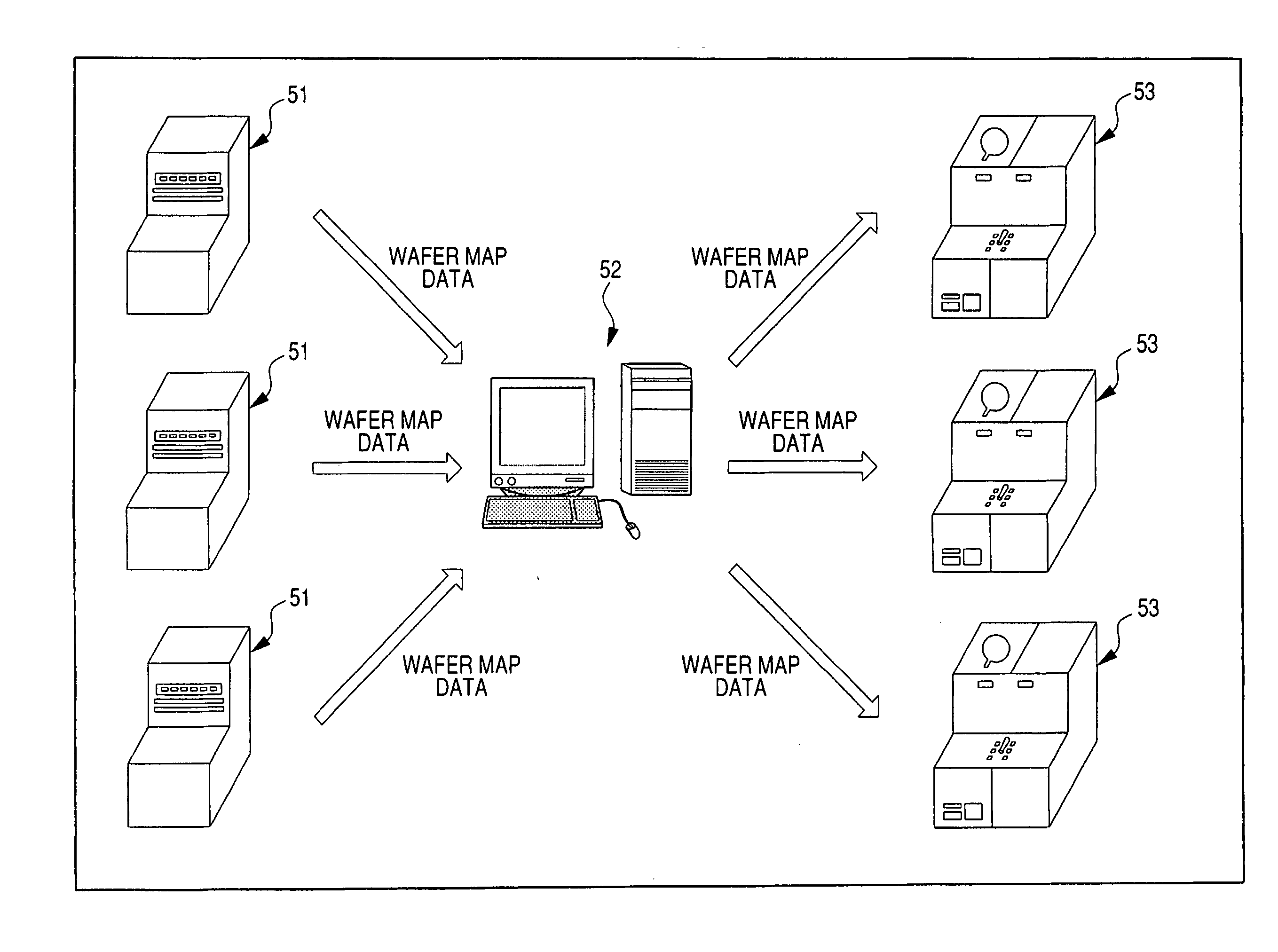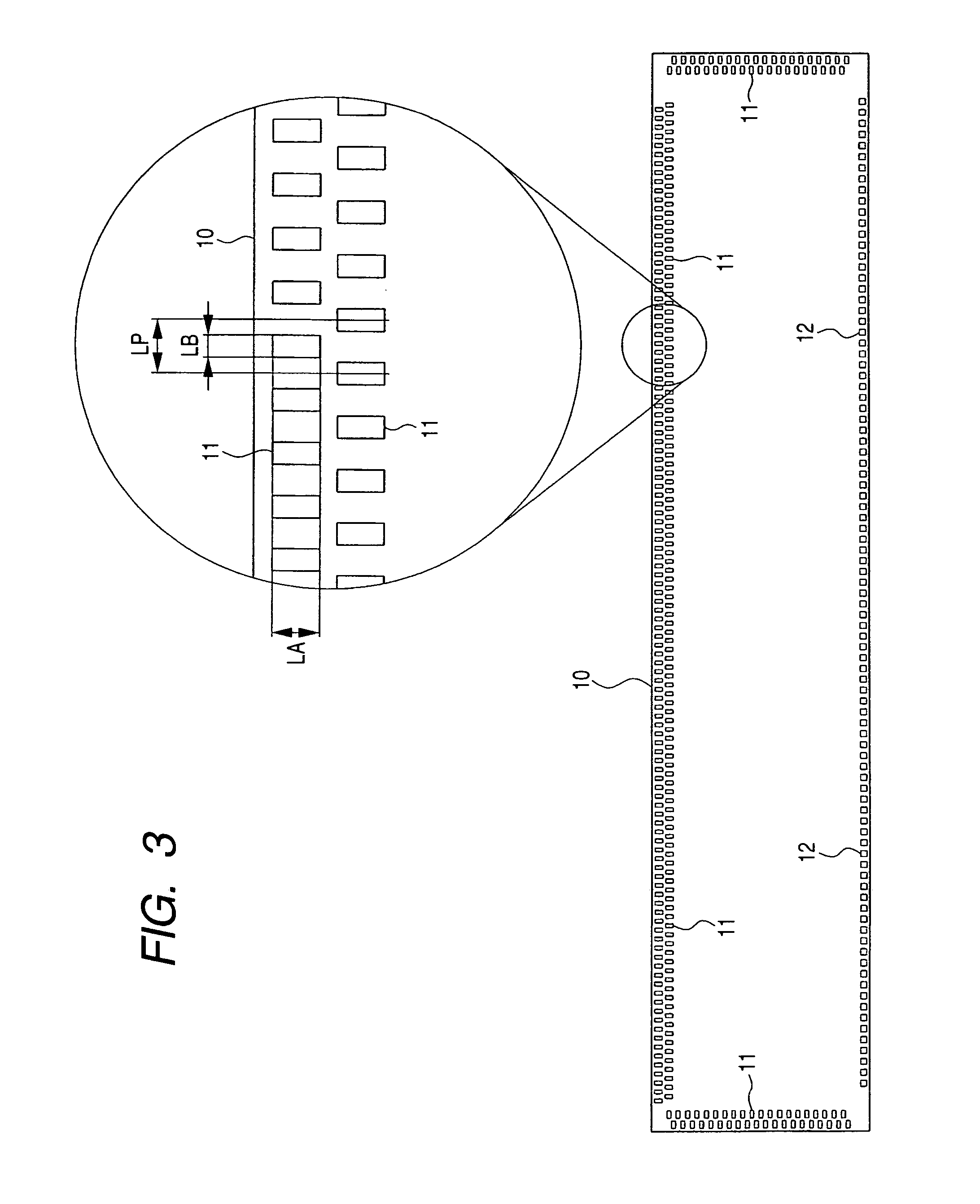Fabrication Method of Semiconductor Integrated Circuit Device
a technology of integrated circuit device and fabrication method, which is applied in the direction of semiconductor/solid-state device testing/measurement, semiconductor/solid-state device details, instruments, etc., can solve the problems of difficult alignment of probes with disposed positions of test pads, membrane probes may be broken, so as to prevent the breakage of membrane probes
- Summary
- Abstract
- Description
- Claims
- Application Information
AI Technical Summary
Benefits of technology
Problems solved by technology
Method used
Image
Examples
embodiment 1
[0165]FIG. 1 shows a relevant-part plane view of a bottom of a probe card of embodiment 1, and FIG. 2 is a cross section view along a line A-A in FIG. 1.
[0166] As shown in FIGS. 1 and 2, the probe card (first card) of the embodiment 1 is formed by a multilayer wiring board 1, membrane sheet (membrane probe (first sheet)) 2, and plunger (pressing mechanism) 3 and the like. The membrane sheet 2 is fixed to a bottom of the multilayer wiring board 1 by a holding ring 4, and the plunger 3 is attached to a top of the multilayer wiring board 1. An opening 5 is provided in the center of the multilayer wiring board 1, in which the membrane sheet 2 and the plunger 3 are adhered to each other via an adhesion ring 6.
[0167] On a bottom of the membrane sheet 2, a plurality of probes (contact terminals) 7 in a form of, for example, quadrangular pyramid or quadrangular pyramid trapezoid are formed. A plurality of wiring lines are formed in the membrane sheet 2, each of the wiring lines being elec...
embodiment 2
[0206] Next, embodiment 2 is described.
[0207]FIGS. 43 and 44 show relevant-part section views of a chip 10 having an LCD driver formed therein, which was described also in the embodiment 1, and show cross sections different from each other.
[0208] A substrate 61 (wafer WH) includes a p-type single-crystal Si, and in a device formation surface as a main surface of the substrate, an isolation part 62 is formed to define active regions La and dummy active regions Lb. The isolation part 62 includes a silicon oxide film formed by, for example, a LOCOS (Local Oxidation of Silicon) process. However, the isolation part 62 may be formed by an isolation part 62 in a groove type (SGI: Shallow Groove Isolation or STI: Shallow Trench Isolation).
[0209] For example, a pn-junction diode D is formed in an active region La enclosed by the isolation part 62 in the substrate 61 as a layer under a pad PD1 as shown in FIG. 43. The pn-junction diode D is, for example, a protective diode for preventing e...
embodiment 3
[0216]FIG. 47 shows a cross section view showing a relevant part of a semiconductor chip in which a semiconductor integrated circuit device of embodiment 3 is formed, wherein a section at the left on paper shows a region where a stacked wiring is formed, and a section at the right on paper shows a region where a bonding pad (hereinafter, simply refer to pad) is formed.
[0217] A p-type well 82 is formed over a main surface of a substrate 81 including p-type single crystal Si (silicon), and an element isolation groove 83 is formed in an element isolation region of the p-type well. The element isolation groove 83 is in a configuration where a groove formed by etching the substrate 81 is filled with an insulating film 84 such as a silicon oxide film.
[0218] N-channel type MISFET Qn mainly includes a gate oxide film 85, gate electrode 6, and n-type semiconductor regions (source, drain) 87 in an LDD (Lightly Doped Drain) structure. The gate electrode 6 is formed by a 3-layer conductive fi...
PUM
 Login to View More
Login to View More Abstract
Description
Claims
Application Information
 Login to View More
Login to View More - R&D
- Intellectual Property
- Life Sciences
- Materials
- Tech Scout
- Unparalleled Data Quality
- Higher Quality Content
- 60% Fewer Hallucinations
Browse by: Latest US Patents, China's latest patents, Technical Efficacy Thesaurus, Application Domain, Technology Topic, Popular Technical Reports.
© 2025 PatSnap. All rights reserved.Legal|Privacy policy|Modern Slavery Act Transparency Statement|Sitemap|About US| Contact US: help@patsnap.com



